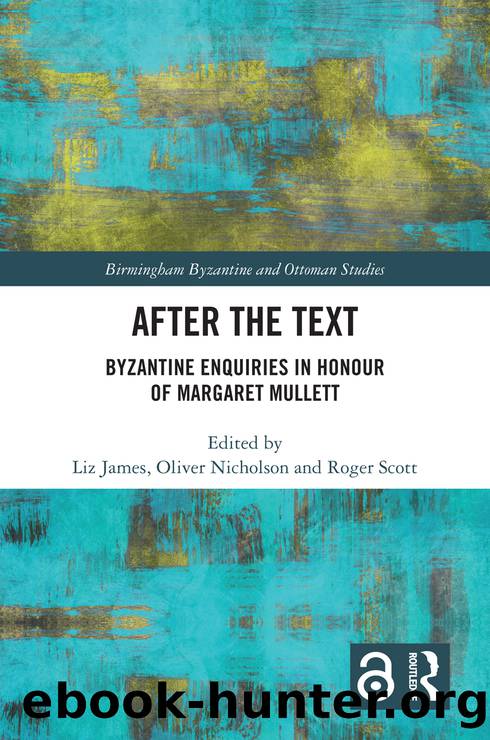After the Text by Liz James;Oliver Nicholson;Roger Scott;

Author:Liz James;Oliver Nicholson;Roger Scott;
Language: eng
Format: epub
Publisher: Taylor & Francis (Unlimited)
Published: 2021-10-02T00:00:00+00:00
Karl Schenkl has, however, noted the similarity between Basilakesâ version and that from the gnomological collection from Marc. gr. 507.16 Schenkl has speculated that Basilakes might have used this very manuscript but this remains a matter of conjecture. What is, however, even more interesting, is that Basilakes chose a line that is part of the gnomological collection. In fact the material for the previous exercise, line 522 from the Ajax (ÏάÏÎ¹Ï ÏάÏιν Î³Î¬Ï á¼ÏÏιν ἡ ÏίκÏÎ¿Ï Ïâ á¼ÎµÎ¯), is also to be found in the same manuscript.17 This raises an interesting but perhaps unanswerable question â to what extent did the Byzantines in the 12th century rely more on the gnomologia and the summaries of the plays rather than on the complete works? John Tzetzes, Basilakesâ contemporary, explains the origins of a well-known saying, á¼¥ÎºÏ Î½ÎµÎºÏῶν ÎºÎµÏ Î¸Î¼á¿¶Î½Î± Ïε καὶ ÏÏÎ»Î±Ï á¼ÏÎµá½¶Ï ÏκÏÏÎ¿Ï , by summarizing Hekabeâs beginning (Histories,10.14), as the phrase is the opening line of the play. Before quoting the line from the Hekabe, he addsοá½ÏÏ ÎºÎ±Ïâ á¼ÏÎ¿Ï Î»Îγει δε διὰ Ïοῦ Îá½ÏιÏÎ¯Î´Î¿Ï (âIn this manner, word by word, he speaks owing to Euripidesâ). Perhaps this does not disprove Hekabeâs popularity but it is somewhat surprising that Tzetzes chose to discuss a very famous quotation from the first play that Byzantine students were supposed to read. What would be the point of doing so if this was the most popular Euripidean drama, which presumably constituted âa first step in the school curriculumâ?18 Perhaps the truth lies somewhere in the middle â the number of those familiar with the entire plays was much lower than those who knew, or were taught, only fragments.
Be that as it may, there are other indications, scattered throughout various texts mostly of didactic character, which seem to suggest that in the 11th and 12th centuries popularity, and perhaps most importantly usefulness,19 of Euripides was matched, if not even surpassed, by that of Sophocles.
Nigel Wilson has drawn the attention to the letter of John Mauropous addressed to an anonymous schoolboy.20 The letter opens with the following question:
ΠοÏαÏá½¸Ï á¼¡Î¼á¿Î½ á¼Ïα καὶ ÏÎ¯Ï á½ Î³ÏαμμαÏικÏÏ; ÏÏÏεÏον ΣοÏÏÎºÎ»ÎµÎ¹Î¿Ï á¼¢ á¼ÏιÏÏοÏÎ¬Î½ÎµÎ¹Î¿Ï á¼¤Î´Î·; (ep. 74 ed. Karpozilos)
What sort of grammarian do we now have among us, and of what style? Is he Sophoclean? Or by now Aristophanic? (transl. N.Wilson)
Download
This site does not store any files on its server. We only index and link to content provided by other sites. Please contact the content providers to delete copyright contents if any and email us, we'll remove relevant links or contents immediately.
| Africa | Americas |
| Arctic & Antarctica | Asia |
| Australia & Oceania | Europe |
| Middle East | Russia |
| United States | World |
| Ancient Civilizations | Military |
| Historical Study & Educational Resources |
Empire of the Sikhs by Patwant Singh(22759)
The Wind in My Hair by Masih Alinejad(4836)
The Templars by Dan Jones(4556)
Rise and Kill First by Ronen Bergman(4542)
The Rape of Nanking by Iris Chang(4020)
12 Strong by Doug Stanton(3418)
Blood and Sand by Alex Von Tunzelmann(3055)
The History of Jihad: From Muhammad to ISIS by Spencer Robert(2504)
Babylon's Ark by Lawrence Anthony(2427)
The Turkish Psychedelic Explosion by Daniel Spicer(2245)
No Room for Small Dreams by Shimon Peres(2235)
Inside the Middle East by Avi Melamed(2230)
Gideon's Spies: The Secret History of the Mossad by Gordon Thomas(2229)
Arabs by Eugene Rogan(2193)
The First Muslim The Story of Muhammad by Lesley Hazleton(2153)
Bus on Jaffa Road by Mike Kelly(2034)
Come, Tell Me How You Live by Mallowan Agatha Christie(2022)
Kabul 1841-42: Battle Story by Edmund Yorke(1921)
1453 by Roger Crowley(1878)
